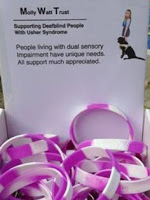So you’re intrigued to know what Ushers is. No, it’s not a typo. It’s not this famous singer.
Nor are we discussing Ushers who will direct you to your seat at a wedding ceremony.
No, it is much more serious than that. Ushers or Usher syndrome is a rare genetic disability that develops multiple symptoms. The major symptoms involve the individual losing hearing and an eye condition called retinitis pigmentosa. It is currently incurable.

Retinitis pigmentosa leaves the carrier of the disability with night blindness and a loss of peripheral vision, which is due to the progressive degeneration of the retina. As retinitis pigmentosa further develops, it will leave the individual with only the ability to see straight ahead. This also leaves carriers of the disability to have problems with their balance.
Who Is Affected by Usher Syndrome?
– An estimated 3,545 people from the UK have Usher syndrome
– Approximately 3 – 6 % of all children who are deaf and another 3 – 6 % of all children who are hard of hearing have Usher syndrome
– In developed countries, an estimated 1 in every 25,000 children will experience Usher syndrome
What Causes Usher Syndrome?
Usher syndrome is genetically inherited, meaning a parent will pass it to their child genetically. With genes being present in almost every cell of the body and containing information that tells cells what to do, a break in this pattern can damage that area of the body. Every person will inherit two copies of each gene, one from the father and one from the mother. Sometimes genes can become altered or mutated. This can cause cells to act differently than expected.
Usher syndrome is inherited as an autosomal recessive trait. The word autosomal means that the mutated gene is not located on either of the chromosomes that determine a person’s sex; in other words, both males and females can have the disability and can pass it along to a child.
The word recessive means that to have Usher syndrome, a person must receive a mutated form of the Usher syndrome gene from each parent. If a child has a mutation in one Usher syndrome gene, but the other gene is normal, he or she is predicted to have full sight and hearing. People with a mutation in a gene that can cause an autosomal recessive condition are called carriers because they ‘carry’ the gene with a mutation. Still, they do not display the symptoms of the disability. If both parents are carriers of a mutated gene for Usher syndrome, they will have a 25% chance of having a child with Usher syndrome with each birth.

Usually, parents who have full use of their hearing and vision; do not know if they are carriers of an Usher syndrome gene mutation. Currently, it is not possible to determine whether a person who does not have a family history of Usher syndrome is a carrier.
There Are 3 Types of Usher Syndrome. What Are They?
Type 1
The most severe case of Usher syndrome. Children born with type 1 are profoundly deaf upon birth and will also experience severe balance problems. The use of hearing aid provides little to no use for these children. Because of the balance problems that will occur, children with this type of Usher syndrome will be slow to sit without support and are unlikely to walk on their own before they are 18 months.
These children usually develop vision problems in early childhood, almost always before age 10. These vision problems will often begin with difficulty seeing at night and then deteriorate quickly until the person is completely blind.
If a child is diagnosed with type 1 Usher syndrome early on, before he or she loses the ability to see, that child is more likely to benefit from the full spectrum of intervention strategies that can help him or her participate more fully in life’s activities.
Type 2
Children born with type 2 Usher syndrome will have moderate to severe hearing loss and normal balance. Although the severity of hearing loss varies between children, most of these children will gain benefits from hearing aids and will be able to communicate orally. Type 2 tends to progress slower than type 1, with the full effects often not apparent until their teenage years.
Type 3
This type, Type 3 Usher syndrome, sees children born with full hearing and near-normal balance. Some may develop balance issues later on in life. Their hearing and sight will worsen over time, but the rate at which they decline varies between people, even within the same family. Hearing loss may develop by the teens, and he or she will usually require hearing aids by mid-to-late adulthood. The loss of vision at night typically occurs around puberty, with blind spots appearing by the late teens to early adulthood. By mid-adulthood, the person will likely be classified as legally blind.
How Is Usher Syndrome Diagnosed?
Due to the hearing, balance and vision being affected by Usher syndrome, all three senses are evaluated to diagnose Usher syndrome. Evaluation of the eyes can include a visual field test to measure a person’s peripheral vision. An electroretinogram (ERG) measures the electrical response of the eye’s light-sensitive cells. A retinal examination is to observe the retina and other structures in the back of the eye.
An audiological (hearing) evaluation measures how loud sounds need to be before a person can hear them. To help diagnose an imbalance, an electronystagmogram (ENG) test measures involuntary eye movements that could signify a balance problem.
Gaining an early diagnosis of Usher syndrome is very important. The earlier that parents know if their child has Usher syndrome, the sooner that child can begin special educational training programs to manage the loss of hearing and vision.
If you’d like to read a story about someone living with Usher syndrome, check out the inspirational Molly Watt CLICK HERE


